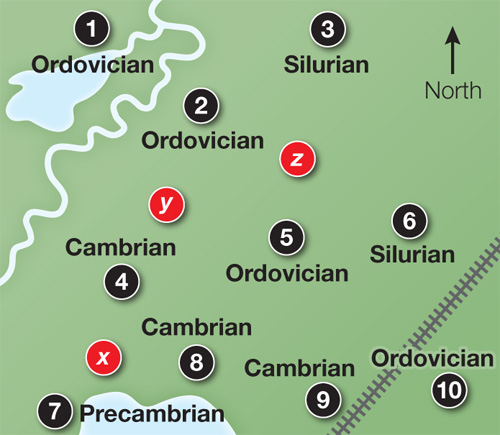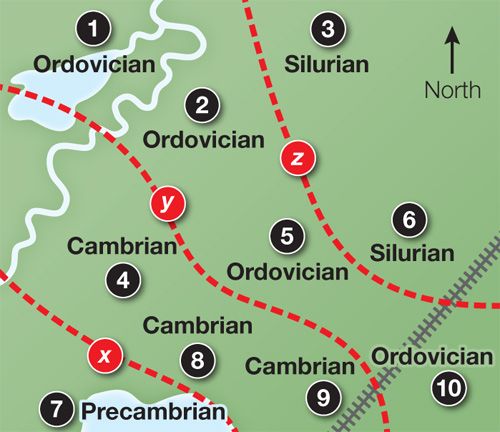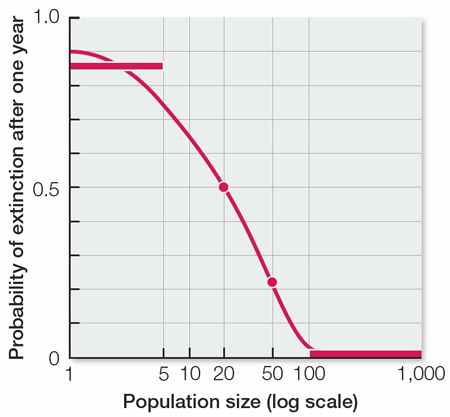Chapter 24
RECAP 24.1
 Page A-26
Page A-26
Site z falls near the predicted border between the Ordovician and Silurian periods on the map shown in the answer to Question 2. Therefore it would be the best site to examine to refine the border between these two periods.
RECAP 24.2
Climate refers to long-
term average expectations of weather at a given location; weather refers to the daily events. Even if the long- term expectations of climate are of gradual warming, we still expect occasional winter blizzards at a given location away from the tropics. A long- term increase in the average temperature of 1°C represents a major climate change, but we would still expect a wide range of temperature conditions throughout the year at a given location. Several major environmental changes occurred near the end of the Precambrian. This was the end of the “snowball Earth” period, when life was likely confined to a few relatively warm areas, such as hot springs and thermal vents. Warming of Earth resulted in rapid diversification of life. There was also a rapid accumulation of oxygen in the atmosphere. Multicellular organisms have higher metabolic requirements than do single-
celled organisms. As O2 accumulated in Earth’s atmosphere from the earliest photosynthetic organisms, it was initially toxic to the single- celled, anaerobic organisms that existed on early Earth. Some species evolved to tolerate and then use O2 for aerobic respiration, which allowed the evolution of large colonies of organisms. Eventually, cooperation among the different individuals in the multicellular colonies led to the evolution of integrated, multicellular organisms.
RECAP 24.3
A major factor was the evolution of two genes in legumes that allowed these plants to use atmospheric nitrogen directly by forming symbioses with a few species of nitrogen-
fixing bacteria. This change dramatically increased the amount of nitrogen available for terrestrial plant growth. The Archean and Proterozoic eons lasted about 1.3 billion and 2.0 billion years, respectively, compared with the 0.542 billion years of the Phanerozoic eon. Yet most of the tree depicts events in the much shorter Phanerozoic eon, since most of the major groups of life shown on the tree diverged during this time. If the tree depicted time proportionally, the branches at the base of the tree would need to be much longer. However, if this change were made, the divergence of the eukaryotes would be so compressed that their relationships could not be shown clearly on one page.
WORK WITH THE DATA, P. 516
Since W = S(1 + R)N, then W = (1 g)(1.0001)50,000 = 148.38 grams.
The Permian lasted 48 million years (299 mya to 251.0 mya); therefore 50,000 years represents about one-
thousandth of this time, or 0.1 percent. Given that even a very modest increase in body size of 0.01 percent per generation is enough to result in an increase in body mass from 1 gram to more than 148 grams in just 50,000 years; that 50,000 years represents only about one-
thousandth of the Permian; and that the experiment shows that increases in atmospheric oxygen can result in much more rapid evolution of insect body size than calculated above, it seems reasonable to conclude that the increased oxygen concentrations during the Permian were sufficient to account for the evolution of giant dragonflies.
WORK WITH THE DATA P. 517
First, plot the data from the table:

Then approximate an extinction curve from the plotted points:

The survivorship after 2 years would clearly be lower than after 1 year. After 1 year, about half the populations of size 20 would go extinct. To calculate the number that would go extinct after 2 years, you would need to know the distribution of population sizes among the half of the populations that did not go extinct in the first year. If we assume that the average size of the surviving populations was still 20 after 1 year, then we would expect another half of the remaining populations to go extinct in the second year (for a 2-
year extinction rate of 75 percent of the original populations).
FIGURE QUESTIONS
Figure 24.3 There is a spreading zone in the middle of the Pacific Ocean where new lithospheric crust is forming. This pushes the oceanic plates on either side to the east and west, forming subduction zones where to oceanic plates meet continental plates on both sides of the Pacific Ocean.
Figure 24.4 When Earth cools, more of its water is tied up in ice on land, in the form of glaciers. Thus there is less water in the oceans, so sea levels are lower.
Figure 24.8 Ash and gases produced by massive volcanic eruptions near the end of the Permian blocked sunlight and resulted in rapid cooling of Earth. There was massive die-
APPLY WHAT YOU’VE LEARNED
The Ediacaran fossils would have been discovered in older sedimentary strata lying below younger strata where Cambrian-
type shelly biota fossils were found. There may have been some overlap where both fossil types were found. The time line provides evidence for this answer, since it indicates that Ediacaran fossils are older than Cambrian- type shelly biota and that there was a short period during which both were present simultaneously. The Ediacaran fauna evolved only after levels of atmospheric oxygen were high enough to support multicellular life forms. Therefore one factor that favored the success of the Ediacaran was the increase in atmospheric oxygen that occurred at this time. Another factor was the ending of glaciation events, which occurred as Earth warmed. The resulting loss of ice cover allowed sunlight to penetrate seawater more effectively, which spurred increased rates of photosynthesis. This further increased oxygen concentrations in aquatic environments. Warmer temperatures in general increased reaction rates, including those in life forms to speed their growth and reproduction; this also favored success of the Ediacaran fauna at that time in Earth’s history.
The physical environment remained favorable for the evolution of multicellular organisms, since the Cambrian-
type shelly biota also arose during this time period. Therefore it was not the physical environment that led to the extinction of the Ediacaran fauna. Most likely, the Ediacaran animals were preyed on by other organisms. They would have been easy prey since they were sessile and large and lacked protective exoskeletons. The Cambrian- type shelly biota were better protected. Their exoskeletons and motility made them much less vulnerable to predation, and thus to extinction. The statement suggests that the lack of fossil discovery does not mean that organisms producing those fossils did not exist. The lack of discovery of fossils may just mean that fossils exist but have not yet been found, or that the organisms died without leaving fossils, or that fossils were formed but have degraded over time. We have to keep open the possibility that the Ediacaran biota lived before or beyond the time period for which we have fossil evidence at present. However, until such evidence is found, the available evidence supports the hypothesis that the Ediacaran fauna arose and went extinct in the time period shown in the diagram.
- Page A-27
Suppose a geological formation is dug up and surveyed for the presence of fossils. If Ediacaran fossils are found in the same strata as fossils of organism X, one could conclude that organism X existed in the same time period as the Ediacaran biota. This would date the existence of organism X to the same time period as the Ediacaran biota. This would be possible because fossils located in the same strata were deposited in sediment at the same time. The dating of the strata would be possible because the Ediacaran biota existed in a fairly narrow time window. This would all change, however, if new evidence placed Ediacaran biota at an earlier or later time than what scientists have observed so far.